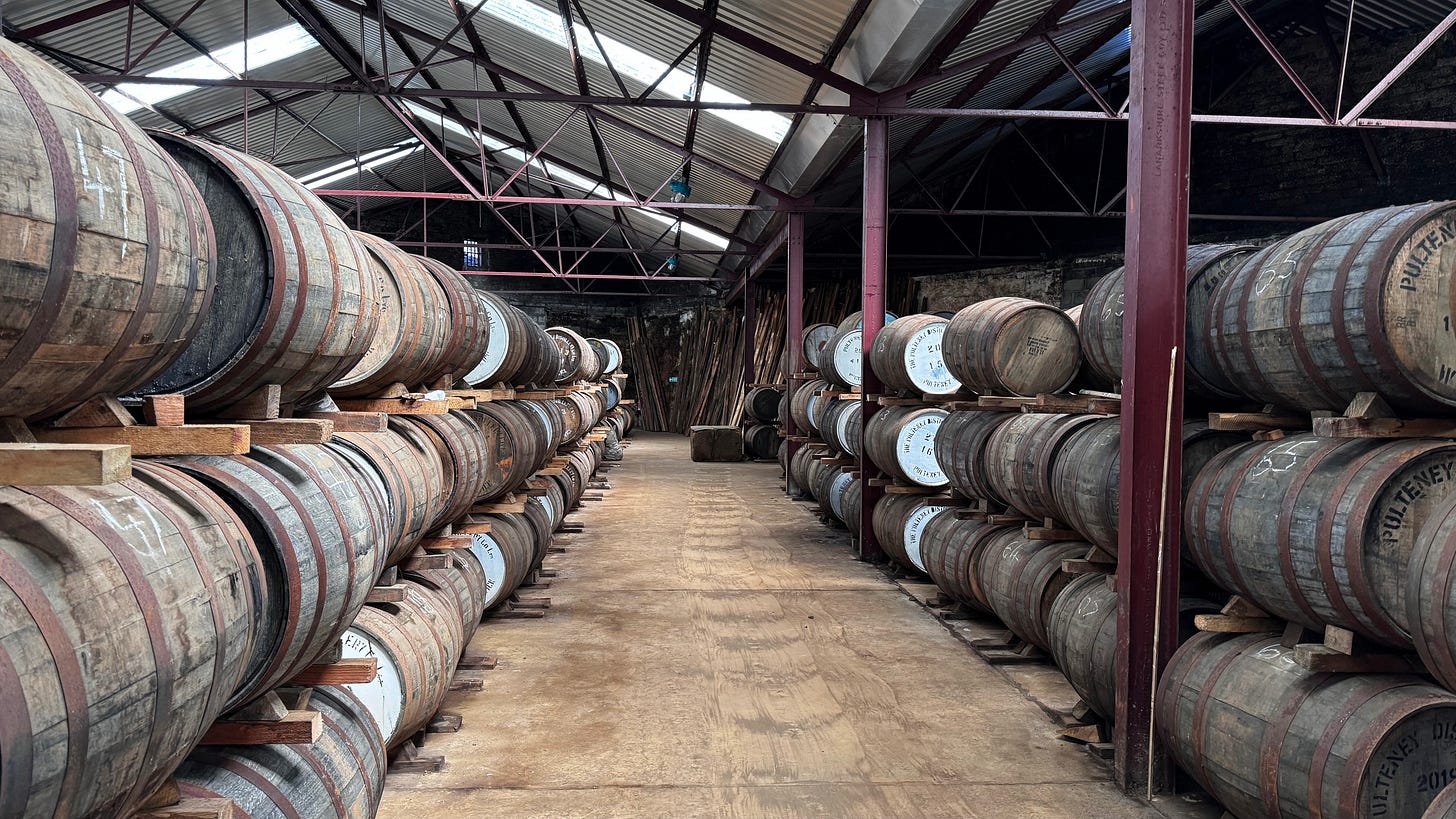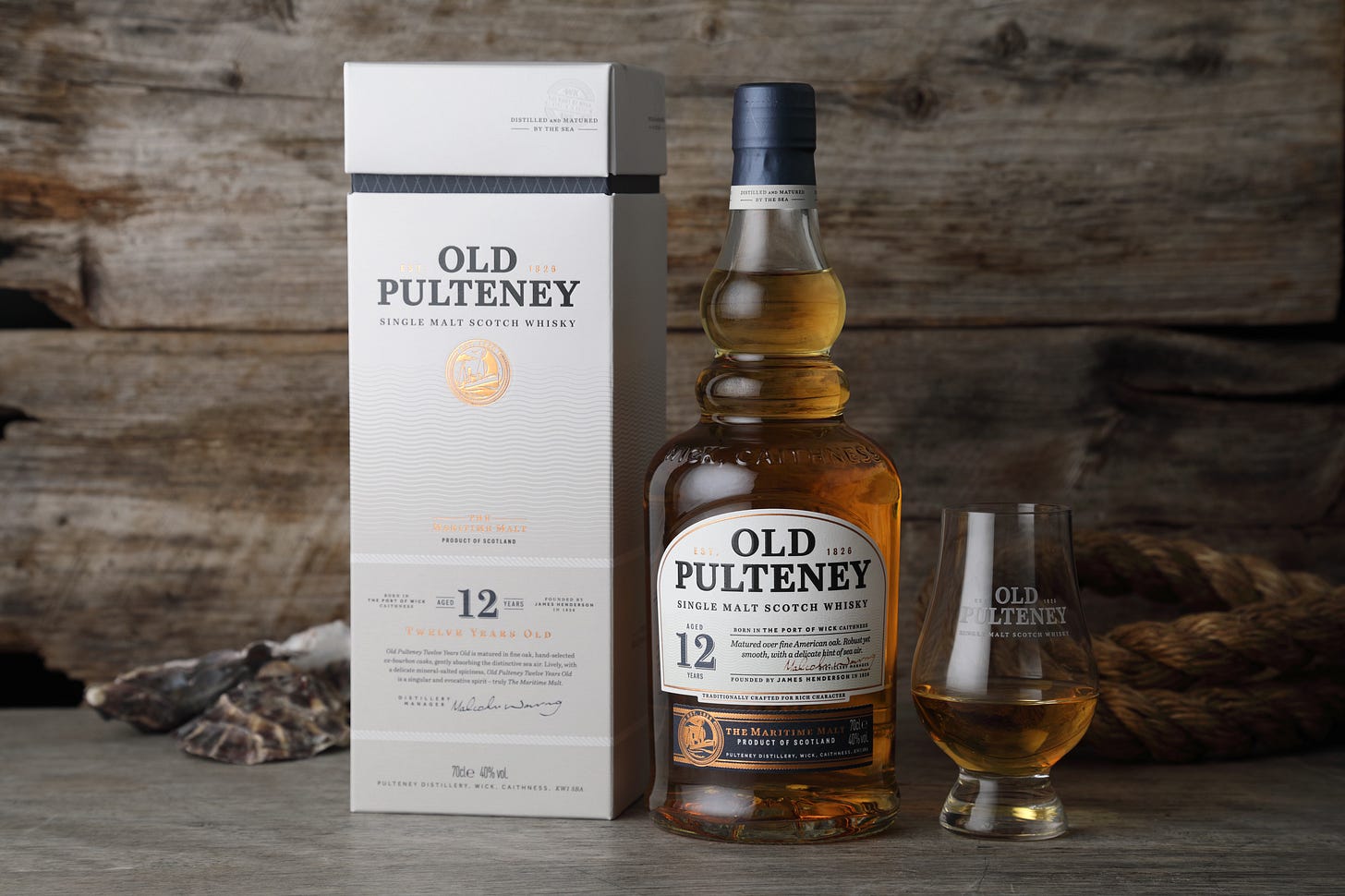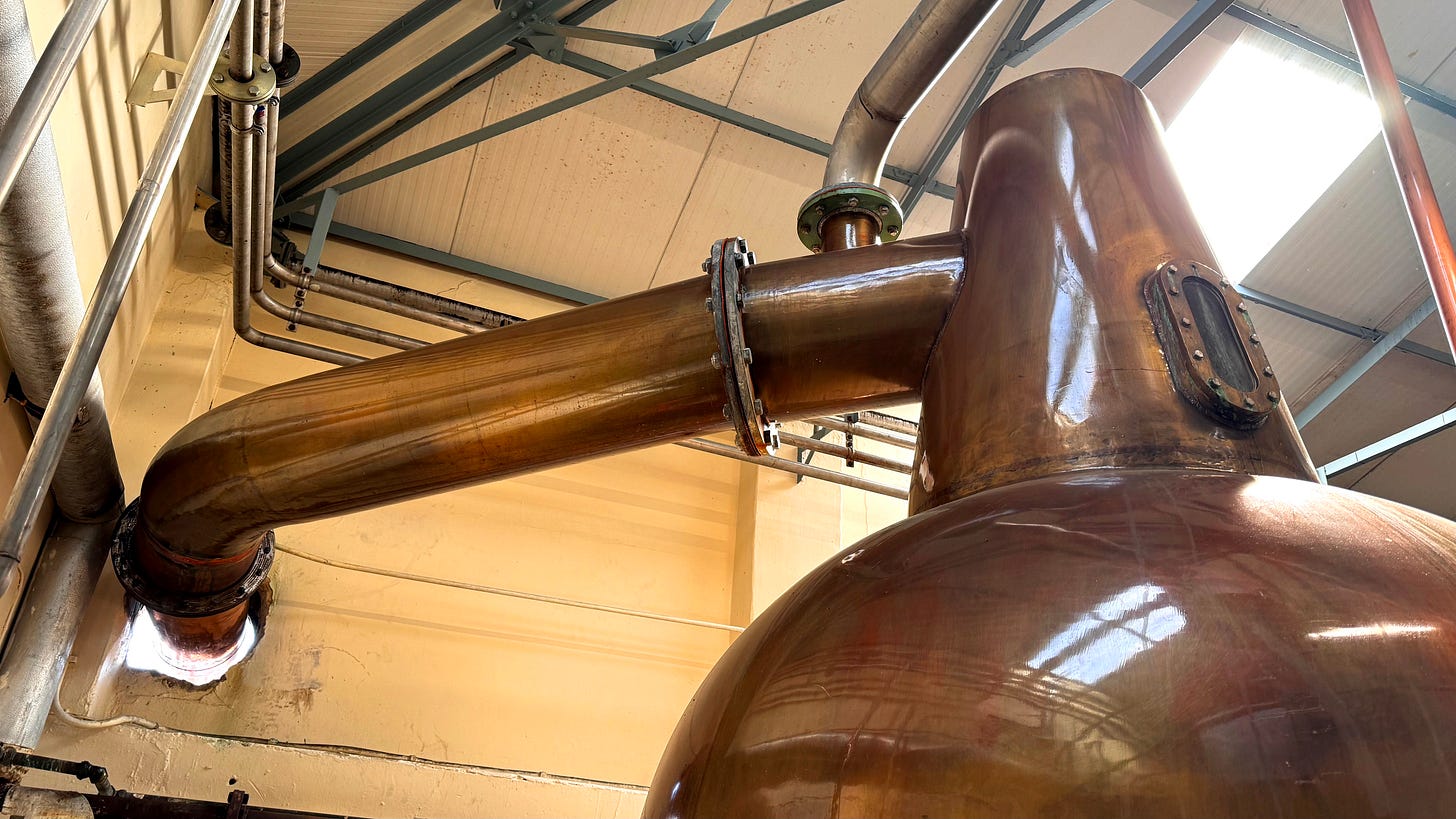I visited Old Pulteney Distillery and learnt a lot!
Old Pulteney, known as the "Maritime Malt," is located in the northern Scottish town of Wick. When I saw Northern I really mean it, being a mere 16 miles from John o' Groats. The distillery is deeply intertwined with the maritime heritage of this historic port, as I discovered on a recent visit.
Founded in 1826 by James Henderson, the Pulteney Distillery emerged during Wick's heyday as one of Europe's busiest herring fishing ports. The distillery is named after Sir William Pulteney, a significant figure in the British Fishery Society, who played a key role in developing Wick as a fishing centre. The port's bustling activity greatly influenced the distillery's operations, with the whisky often transported by sea alongside barrels of herring.
In its early days, Old Pulteney thrived, with whisky production closely tied to the fishing industry. The remote location of the distillery made sea transport essential, but these were hard days. I witnessed first-hand on a brilliant sea safari, the small coves where some of the 1000+ fishing vessels (at its peak) would land with their daily catch. Our guide told the story of how hundreds of workers would prepare the fish, placing them in barrels and hand-rolling them up rocky cliffs on makeshift paths. This provided employment within the community for not only the fishing industry, but the coppers making thousands of barrels.
The late 19th and early 20th centuries brought ownership changes and challenges, including Prohibition in the United States and the economic downturns following the World Wars. Despite these obstacles, Old Pulteney survived, thanks in part to the resilience and dedication of the Wick community. During these tumultuous times, the distillery continued to produce its whisky, albeit in smaller quantities.
In the 1950s, the distillery underwent significant modernisation under Robert “Bertie” Cumming, who also owned Balblair Distillery. This renewal stabilised production and improved quality. Innovations during this period included updates to the distillation process and enhancements to the maturation facilities, which helped maintain the whisky's high standards. In the latter half of the 20th century, Old Pulteney gained recognition, winning several prestigious awards in the 21st century, such as the "World's Best Single Malt" at the World Whiskies Awards in 2012 for its 21-year-old expression.
Visiting the distillery provides a true sense of its character, from the people working there to the local environment. Old Pulteney, though covering a large area, is modest in size. In the close-knit community of Wick, there is a palpable sense of togetherness and long-term commitment among the staff. For example, I saw a team member washing a car for a work trip who also took the time to hose down empty barrels to prevent drying and leakage. This level of care and dedication is evident throughout the distillery.
Malcolm Waring, the distillery manager, has over 25 years of experience and a deep passion for whisky-making. Under his stewardship, Old Pulteney has continued to thrive, maintaining its traditional methods while embracing sustainable practices. We had an insightful discussion about whisky terroir and the distillery's sustainability efforts, which exceed targets and go beyond mere token gestures. For instance, the distillery has implemented energy-saving measures and reduced its carbon footprint significantly.
My first visit to the distillery was in 2021, whilst driving the NC500, just after lockdown. At that time, only the shop was open, so it was exciting to finally see the distinctive Stills here. The Lyne arm is an angled pipe that connects the top of the pot still to the condenser, where the vaporised alcohol is cooled and turned back into liquid form. The angle and length of the Lyne arm plays a significant role in determining the character of the whisky. At Old Pulteney, it is uniquely partway down the neck of the still. You can learn why in my interview with Malcolm below.
Nothing excites me more about the distillation process than when a distillery has a “worm tub” Worm tubs are traditional copper coil condensers, ordinarily located outdoors. They consist of a large vat filled with cold water, through which a long copper coil, or "worm," runs. As the hot vaporised alcohol from the still passes through the lyne arm into the coil, it condenses back into liquid form. This method of condensation is known for producing a heavier, richer spirit with robust and complex flavours due to the reduced copper contact compared to more modern condensers, which leads to less removal of heavier compounds and impurities.
The use of worm tubs is relatively rare with only a small number of distilleries in Scotland continuing this traditional method. As of recent counts, only around 12 distilleries still use them. At Old Pulteney, they are 108m in length for the wash still and 106m for the spirit still.
The distillery sources its water from Loch Hempriggs, transported via a lade designed by Scottish engineer Thomas Telford in 1807. Despite the distillery's formation in 1826, this lade is still used to channel water directly into the distillery.
They use a century-old Porteus mill to process five tonnes of local un-peated malt barley into grist every two and a half hours, totalling 160 tonnes in a 12-day cycle. These mills were so efficient that Porteus went out of business as replacements were rarely needed. Malcolm has enhanced it for greater efficiency, producing 410 litres of alcohol spirit per tonne milled.
Traditional dunnage warehouses with thick stone walls provide an ideal environment for whisky maturation, allowing sea air to interact with the casks over time. These warehouses are my favourite part of the distillery, offering a quiet space to observe the slow maturing process in various cask types. I learnt from Malcolm that the 15-year-old is first matured in a more modern racking warehouse for 12 years, and then transferred to the dunnage warehouse for 3 years. The 18-year-old is fully matured in the dunnage warehouse for the entire duration. I find these distinctions fascinating.
Sustainability is a major focus for Old Pulteney, far exceeding my expectations. Over twenty years ago, Wick was recognised as a socially deprived area, and in 2012, it became part of one of the UK’s first District Heating Schemes. By using locally sourced wood chips to power a 3.5-megawatt biomass boiler, they generate renewable steam for production and provide energy to over 200 homes and public buildings, including Wick General Hospital. This initiative has significantly reduced emissions and offers the local community a green, low-cost energy supply.
The Whiskies
Old Pulteney 12-Year-Old
This is the core of the Old Pulteney range. Matured in hand-selected ex-bourbon casks, it boasts a golden amber colour and a distinctive nose with hints of apple and pear, combined with a slight brininess. On the palate, it offers a balanced mix of honey, cream, and subtle spices, leading to a long, smooth finish
Old Pulteney 15-Year-Old
Matured in a combination of ex-bourbon and Spanish oak casks, this whisky offers a richer and more complex profile. The nose is aromatic with hints of vanilla, citrus, and chocolate, while the palate reveals layers of dark fruits, spices, and a characteristic coastal saltiness. After spending 12 years in the racking warehouse, this whisky is transferred to the dunnage warehouse for an additional three years, adding depth and complexity to its flavour profile.
Old Pulteney 18-Year-Old
This has been aged in American oak ex-bourbon casks and Spanish oak casks. It presents a deep amber colour and a nose filled with rich toffee, chocolate, and a touch of sea breeze. The palate is full-bodied, with flavours of dark chocolate, dried fruit, and a lingering finish. The whisky is fully matured in the dunnage warehouse, enhancing its character and depth.
Old Pulteney Huddart
Named after the street where the distillery is located, this whisky is finished in casks that previously held peated whisky. It has a unique smoky character, with notes of campfire smoke, vanilla, and honey on the nose. The palate features peat smoke, spices, and a sweet maltiness, creating a blend of smoky and sweet flavours.
Old Pulteney French Oak
A distillery exclusive, this expression is full of flavour, blending spice with citrus fruit and a hint of salinity. The palate follows with notes of honey, roasted hazelnuts, and crème brûlée, but it maintains a dry character rather than sweet, offering a delightful balance. It was initially matured in American oak before being transferred to French.
Old Pulteney Pineau des Charentes (The Coastal Series)
The first release in the Coastal Series, this whisky is matured in casks that previously held Pineau des Charentes, a fortified wine made by the sea. It has a jammy, rich character with notes of ripe berries and sweet fruit preserves on the nose. The palate is full of red fruits, honey, and a subtle maritime influence. It finishes with a smooth, lingering sweetness balanced by a touch of salinity.
An interview with Malcolm Waring
How did you get started in the whisky industry?
I’ve been at the helm of Pulteney Distillery for over 17 years. I was raised in Wick and began my career working for a local boat-builder before starting on the first rung of the whisky ladder with the Pulteney team back in 1990. I worked my way through all areas of the distillery - the mash room, the stills and the warehouses – and slowly learnt the craft of making fine single-malt Scotch whisky. I eventually progressed to Brewing Manager and then Assistant Distillery Manager, before moving to Pulteney’s sister distillery, Knockdhu, in my first managerial position in 2000. I led production of anCnoc single malt Scotch whisky for six years, before returning to Pulteney Distillery as Distillery Manager in August 2006 and have been here ever since.
Why is the Lyne arm not at the very top of the Still?
We have two uniquely-shaped stills which is where our bottle gets its shape from. Both boast exaggerated boil balls and the wash still in particular is unusual with the lyne arm attached directly to the head of the still without the ‘swan neck’. The maximum capacity of the wash still is 21,707L and the spirit still can take 17,343L. The wash still is 5.2m high and the spirit still is 6m.
The lyne arm of the wash still is slightly descending, and the lyne arm of the spirit still takes the shape of an inverted ‘u’ and then it’s almost level past the purifier. The reason for this is rumoured to be that the measurements for a new still were confused and when it was delivered, it didn’t fit, so they cut the top off and repositioned the Lyne arm. We’ve kept the same design of still ever since the 1920s.
The spirit still also has a unique feature – a lyne arm that resembles a U-bend and is unlike anything else in the industry. This is due to the purifier attached to it – when this was fitted, there wasn’t enough space to keep the lyne arm straight without pushing through the outer wall of the building, so, we adapted the lyne arm.
Why do you still use dry yeast?
There are several reasons we use dried yeast. Firstly, it does not require refrigerated storage and has a longer shelf life whereas pressed yeast has a much shorter shelf life and needs to be refrigerated.
Dried yeasts also offer additional flavour versatility with the potential to be used in combination with other strains to improve flavour in the new make spirit. Dried yeast needs to be rehydrated in a specific manner to achieve optimum results and by managing the process carefully, even better results than pressed or cream yeast formats can be achieved.
Can you explain the impact of the coastal climate on the ageing process?
We like to think that there’s something magical about the maturation process at Pulteney. The low temperature and high humidity affect maturation in our five seaside warehouses. They breathe slowly, allowing for the natural character of the whisky to develop over many years without being overpowered by the wood. Knowing when to rotate and move the casks is an art that I’ve spent years perfecting, as each sub-climate within the warehouses ages the whisky differently.Are there any recent innovations or experimental batches at Old Pulteney that you're particularly excited about?
We recently unveiled the second limited-edition release in The Coastal Series with Old Pulteney Port. The Coastal Series takes whisky drinkers on a voyage of exploration with cask maturations from around the world. To create the Series, we partnered with spirits makers from coastal locations across the globe, further maturing our whisky in a specialist selection of casks and creating four beautifully unique, limited-edition expressions that bring wonderful new coastal flavours to ‘The Maritime Malt’.
Old Pulteney Port is a wonderful marriage of flavours from two iconic spirits both found close to the sea - single malt Scotch whisky from Wick in the Scottish Highlands and Port from the Douro Valley of Northern Portugal. Carefully matured in second-fill ex-bourbon casks, the expression was then further matured in both hand-selected Ruby Port Pipes and barriques, absorbing the rich flavours of the delicious, fortified wine.
The American oak casks, Ruby Port Pipes and Ruby Port Barriques come together beautifully, resulting in a stunning single malt, balanced with sweet and spicy notes and coastal character which Old Pulteney is renowned for.
I love that you have worm tubs. Have you ever tried other more modern condensers to do a comparison?
No, we have never tried condensers at Pulteney for comparison!
Can you please tell me about your sustainability practices and objectives? You mentioned some very impressive numbers.
At Pulteney Distillery, we’re really proud to be recognised as one of the whisky world’s eco pioneers with a dedication to sustainability and community assistance dating back decades. We’re also one of the lowest CO2 producers in the industry!
This was a wonderful visit to the distillery that gave me a far better understanding of their whisky, which I have yet to taste anywhere near enough of. I stayed in a beautiful apartment overlooking the harbour at John o’Groats that was stunning. When I walked down to the harbour to watch the sunset, a dram of Old Pulteney in hand, I couldn’t imagine a more perfect location to sip on a delicious whisky. It was quite magical.
The serene surroundings, combined with the exceptional quality of Old Pulteney, created an unforgettable trip. It’s an experience that captures the essence of both the whisky and the beautiful landscape from which it originates.









